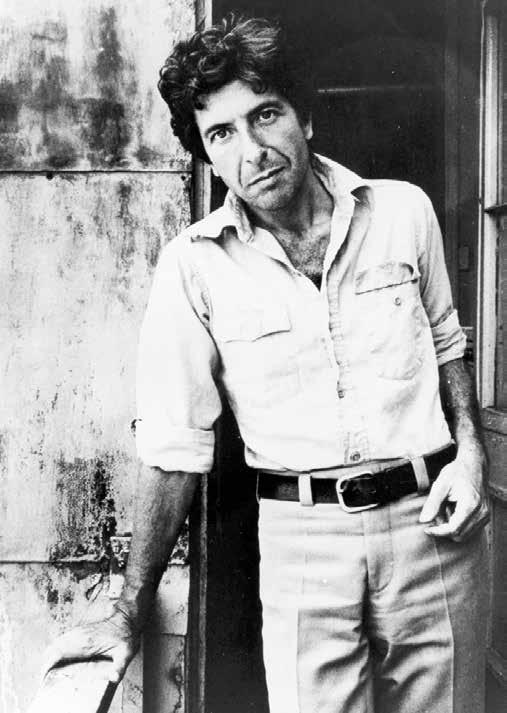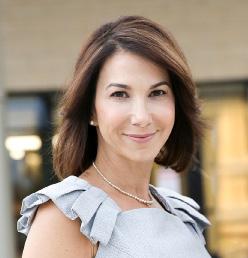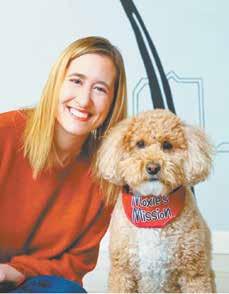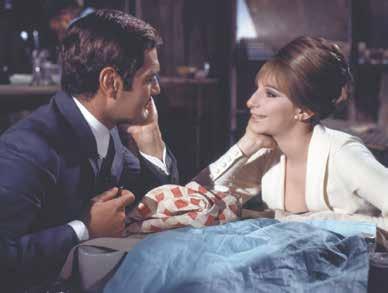
23 minute read
Features
ARTS AND CULTURE FOOD HOLIDAYS LIFESTYLES
Leonard Cohen, in ‘Hallelujah: Leonard Cohen, a Journey, a Song.’
Advertisement
PHOTOS COURTESY OF LEONARD COHEN FAMILY TRUST / SONY PICTURES ENTERTAINMENT INC.
Hallelujah: Film tells fascinating story of Leonard Cohen and his miracle song
BY CATE MARQUIS
SPECIAL TO THE JEWISH LIGHT
Leonard Cohen the artist has long been hailed as a musical giant, but the man has been something of a mystery. The Jewish singer/ songwriter’s most famous composition, “Hallelujah,” started out as a sacred song about King David but became a pop music perennial, covered by a dizzying array of singers. Both the singer and the song are the subject of the excellent documentary “Hallelujah: Leonard Cohen, a Journey, a Song.”
The film is billed as a “definitive exploration” of Cohen’s life and career, and indeed it is, offering insights into the man, his deep connection to his Jewish faith and his process as a writer. The film also is a kind of double biopic on the life of the songwriter and the story of his most famous song, both of which had a rocky journey to fame.
Co-directors Daniel Geller and Dayna Goldfine structure the documentary as three acts, beginning with a more familiar biopic of Cohen’s early life and career, switching to a “biography” of the song (how it was written, its many versions and its slow, unexpected rise to fame), and then returning to Cohen’s journey, including how the unexpected success of the song affected his later life.
Using archival stills, extensive interview footage of Cohen, live performances and interviews with those who knew him, this documentary dives deep into Cohen’s life and work as a poet and a songwriter. The path of his career is balanced with his explorations of his Jewish identity and faith, his interest in Kabbalah, his long sojourn into Zen Buddhism, and then his return to Judaism.
Interview subjects range from musicians such as Judy Collins, Rufus Wainwright and Glen Hansard to important figures in Cohen’s life, such as Rabbi Mordecai Finley, who led the synagogue Cohen attended in his final decade.
Cohen was born in Canada to a wealthy Orthodox Jewish family in Quebec. His Lithuanian-born mother was the daughter of a rabbi and Talmudic scholar, and prominent figures in Jewish life were on his father’s side as well.
Cohen came to music a bit late, at age 30, when he was already a novelist and a poet acclaimed in literary circles. His writing and later his song lyrics were honest and open rather than comforting, with a knowing, dark humor.
When he turned to music in the late ’60s, he was embraced by Collins, Bob Dylan and other folk-rock greats, and he developed a cult following. Wider fame eluded him, however, even as other musicians loved his songs and their poetic, deeply thoughtful lyrics that didn’t always fit into neat categories.
Collins, who scored a hit with her version of Cohen’s “Suzanne,” speaks in the film about the deep influence of Cohen’s Jewish upbringing on his work.
Cohen is asked whether he had considered changing his name, as Bob Dylan and others had done by dropping more Jewishsounding surnames. Cohen slyly replies, deadpan but with a glint in his eye, that, yes, he considered changing his first name to something more Jewish, as his last name was already Jewish enough, cleverly undercutting the question and displaying his quick wit.
The eventual success of “Hallelujah,” which was released in 1984 on Cohen’s album “Various Positions,” gave Cohen a late-in-life career boost until his death at age 82 in 2016.
What about that song? Cohen worked on “Hallelujah” for more than seven years, and it is thought to have had as many as 180 draft verses. Around the time he was writing the song, Cohen had been exploring Kabbalah and Jewish belief. The song started as something sacred, about King David composing a song, set to a 6/8 time signature evoking waltz and gospel music. Cohen recorded a sacred version on “Various Positions,” which his label, Columbia Records, disliked and declined to release in the United States (although an independent label did release it).
As Cohen toured, the lyrics evolved from sacred to secular, with some verses frankly sexual. Meanwhile, other musicians took note of the song. John Cale recorded a cover of it in 1991, combining verses from the sacred and secular versions, which was followed by Jeff Buckley’s recording of that version in 1994. A music producer working on the animated movie “Shrek” (2001) took the Buckley version, sanitized the lyrics, and included it in the soundtrack. A phenomenon was born.
The documentary follows the song’s long and winding road, which takes some very surprising turns, and we hear Cohen reflect with a kind of paternal pride on the impact the song had on his later life.
One intriguing aspect of the film are excerpts from Cohen’s songwriting journals, giving a rare glimpse into his process. Interviews also support this focus, delving deep into Cohen as a poet/songwriter and Jewish spiritual explorer. A long period of living at Zen monastery is followed by a return to Judaism and life as a musician.
Unlike another recent film about Cohen, “Marianne & Leonard: Words of Love,” this documentary focuses more on Cohen’s artistic life than his love life, although it does note Cohen’s reputation as a “ladies’ man.” Interview footage with French photographer Dominique Issermann, who was in a long relationship with Cohen while he was writing “Hallelujah,” has her talking more about the song and songwriting than the affair. There is so much that is surprising, intriguing and deeply insightful about Cohen’s life in this film, and co-directors Geller and Goldfine do a marvelous job of bringing all that out and weaving it all into a very enjoyable and informative experience.

Documentary fillm opens Friday, July 29, at Landmark’s Plaza Frontenac Cinema
AMY FENSTER BROWN
You rock, Daddio — it’s time to ‘honor’ the fathers
BY AMY FENSTER BROWN
In a previous column I created an awards ceremony for moms, but we shouldn’t get all the attention. Dads deserve to be the butt of the joke … I mean, dads deserve praise, too. They should be awarded for all they do, especially when it’s ridiculous and embarrassing.
Let’s call the award the Daddio. It will be a statue of a man asleep at his child’s piano recital. Let’s take a look at the Daddio’s most popular categories.
The Don’t Do-It-Yourself Award
The nominees in this category:
The man who hires someone to do a difficult task like building a retaining wall and stands nearby the entire time with his hands on hips “supervising.”
The dad who runs to the grocery store and ends up calling his wife every single time to ask things like, “Do we buy the pink milk or the blue milk?” It’s as if he doesn’t even live in your house.
The father who attempts to fix the faucet because the guy on YouTube made it look easy, but it wasn’t, and now he basically pays the plumber’s kids’ college tuition.
Most Creatively Frugal Father
The nominees in this category:
The guy who has not one, not two, but three gasoline pricing apps on his phone and uses all three to find the cheapest gas, then drives an extra 10 miles to go there for a fill-up (honestly though, who could blame him these days).
The father who goes to the drugstore and uses long-ago expired coupons because he never bothers to check the date, then asks the clerk if he can use it anyway.
The dad who loves fitness but won’t pay for a personal trainer, so he copies the exercises from a few feet away, stalking a guy who legitimately paid for a personal trainer.
Amy Fenster Brown’s husband, Jeff, manages to catch some Z’s in public, with 300 kids screaming around him.
Columnist Amy Fenster Brown is married to Jeff and has two teenage sons, Davis and Leo. She volunteers for several Jewish not-forprofit groups. Fenster Brown is an Emmy Award-winning TV news writer and counts time with family and friends, talking and eating peanut butter among her hobbies.

BOOK REVIEW Historian takes deep look into friends, foes of Israel’s independence
BY ROBERT A. COHN
EDITOR-IN-CHIEF EMERITUS
The modern Jewish state of Israel marked its recent 74th anniversary of independence in a subdued and troubled mood.
Israel’s fragile year-old coalition had lost its one vote majority in the Knesset. Israeli nationalists encountered violent Palestinian protests in Jerusalem near the Western Wall of the Second Temple, located in the Old City, a site called the Noble Sanctuary by Muslims.
Considering all of the above challenges, Israel enters its 75th year with as many or more obstacles than faced Zionist founders David Ben-Gurion and Chaim Weizmann when the former read out Israel’s Proclamation of Independence on May 14, 1948. That is when the British Mandate over Palestine ended.
In his compelling new book, “Israel’s Moment,” Jeffrey Herf, distinguished professor of modern European history at the University of Maryland, meticulously documents the countless obstacles Israel faced in the crucial period from 1945, when the Nazi death camps were liberated, and 1948, when the first independent Jewish entity was founded in biblical Israel in 2,000 years.
By 1945, the staggering reality that 6 million Jews had been murdered in the Holocaust could no longer be denied or minimized. The Soviet Union, whose army liberated Auschwitz and other death camps, supported the creation of Israel at the United Nations.
Herf gives great weight to speeches given by leading Soviet diplomat Andrei Gromyko that strongly supported statehood for Israel.
Herf also is clear-eyed that Soviet dictator Joseph Stalin was motivated not by the Holocaust but by his desire for the USSR to displace the United Kingdom as the dominant power in the Middle East, which did not happen.
Great Britain, whose wartime Prime Minister Winston Churchill had been an outspoken supporter of Zionism, was turned out in 1945. He was replaced by the Labour Party’s Clement Attlee as prime minister. Attlee and vehemently anti-Israel Foreign Minister Ernest Bevin were more concerned with assuring Britain’s access to Arabian oil than with humanitarian or Big Power dominance of the Middle East.
Herf takes a deep dive into the background of the eventual support and recognition by the United States of the Jewish state in 1948. Both President Harry Truman and his 1948 Republican opponent, Thomas E. Dewey, supported Israel, as did major figures on the American left.
But the Arabist faction in Washington pulled out all the stops to kill support for the Zionist cause. Secretary of State George C. Marshall, a World War II hero and architect of the Marshall Plan to rebuild Europe, feared that an independent Jewish state could quickly become a “Soviet base.” That fear proved to be unfounded as Stalin abruptly turned against not only Israel but against the large Soviet Jewish population.
Herf’s analysis proves the dictum that there are “no permanent friends” among nations but there are “permanent interests.” Fortunately for the infant state of Israel, the United States, led by Truman who overcame Marshall’s opposition, and the USSR, which wrongly feared British dominance of the Middle East, saw it to be in their interests to support the modern miracle of Israel.
Herf’s book is both a good read about behind the scenes diplomacy and a valuable compendium of information about the birth of Israel. ‘Israel’s Moment: International Support for and Opposition to Establishing the Jewish State, 19451949,’ by Jeffrey Herf Cambridge, 500 pages, $39.99
The Night Night in the Day Day Award
The nominees in this category:
The father who parks himself on the couch to watch the game, zonks out snoring before there is even a score, but wakes up the second you try to change the channel.
The man who consistently snores like a boy band made up of grizzly bears but denies it, saying he sleeps like a baby and if he snored, he would hear it.
The dad who happily takes his kids to the children’s museum, sits down for one minute and then falls blissfully asleep while dozens of scurrying youngsters scream in delight all around him. * See photo of my Baby Daddy excelling at this scenario in what was the loudest museum on earth.

Most Embarrassing Sideline Performance

The nominees in this category:
The sports spectator dad who yells orders to the team because he watches that sport on TV so he knows better than the actual coach.
The father who lets his daughter’s friends come over before homecoming but can’t get over how short and inappropriate the girls’ dresses are and cannot believe that’s what the kids are wearing these days.
The man who always takes pictures, stands in everyone’s way saying, “Wait, one more, one second,” and gets 15 shots of the same thing, yet none of them is actually good.
If you know any dads in any of these categories, be sure to congratulate them on their achievements as a contender for the Daddio.
dielmannsothebys.com | 0. 314.725.0009

Global Real Estate Advisor c. 314.954.3999 Beth Manlin Don’t just get it on the market. Get it the attention it deserves. beth.manlin@dielmannsir.com
Healing touch: Therapy dogs dispense love without judgment
CONTINUED FROM PAGE 1
tasks, like serving as a motivational tool during physical therapy sessions. In St. Louis, Duo Dogs has approximately 250 active touch teams that visit 120 facilities each year.
Another local therapy dog organization is CHAMP, with 90 therapy dog teams that visit 80 locations. CHAMP also has one therapy cat.
Rachel Green-Smith is one local CHAMP supporter. Green-Smith, a member of Congregation B’nai Amoona, is quite familiar with the value of touch therapy dogs. She is a licensed mental health counselor and certified clinical trauma professional who first experienced therapy dogs at a rehab facility.
“I have seen the amazing difference therapy dogs have made,” Green-Smith said. “Like patients who have to learn how to move again. Sometimes they have the dog a little bit ahead and the person takes a step and get a pet … then takes another a step and get another pet. To see a therapy dog walk in there and just have that unconditional love, it brings chills when I think about it.
“Therapy dog day was always the best day because spirits were lifted. Sometimes people would get super emotional. Maybe they had a beloved dog when they were young and they haven’t connected to any people like they connected to the dog. There were so many just beautiful ways that these therapy dogs elevated spirits, helped people.”
Comfort and emotional connection
The most important benefit of the touch therapy dog program is simply to provide comfort to people who are sick or scared or lonely, Mirowitz said.
“But they also provide confidence to the dog, and the trainer-owner,” she said. “Everyone experiences this uplift. I’ve never had a negative experience. You always walk out knowing that moment of that second when the person connected with your dog was the true essence of the program.”
There is a unique emotional connection between a dog and person that makes touch therapy work so well, Green-Smith said.
“Dogs don’t judge or correct,” she said. “In a library reading program, the dog isn’t going to pronounce the word for you. The dog’s just going to stare at you with loving eyes and wait for you to be able to pronounce the word on your own. It’s unconditional acceptance. That’s why dogs are so great.”
The Jewish volunteers in touch therapy teams said it’s a situation in which everyone benefits, including the dog. Oliver knows that when his vest goes on, it’s time to work. It’s in a dog’s nature to want to please. For the volunteer, the rewards are immeasurable, Samuels said
“I get more out of it than the people Oliver and I visit,” she said. You walk out after bringing a smile to their faces and you think, ‘I am really a lucky person — when you love your dog as much as I do, and to work with your dog and have a real bonding experience.’ ”

Maxine Mirowitz and Bexley at Duo Dog Gala.
We believe our residents and their families deserve the best memory care possible.


Medical Excellence, Compassionate Care
You want your loved one to get the best memory care available. We know how you feel. That’s why memory care is our primary focus. Parc Provence specialists are experts in their fields and committed to compassionate care. Our residents benefit from the latest in research and best practices, so they can continue to make the best of every day.
Leading the Way in Memory Care (314) 542-2500
PARCPROVENCE.COM
A+ Rating with BBB
Please call to learn more or to schedule a tour. Wheelchair-bound athlete is glad she has some Moxie
Moxie Harris is a bit like a butler. She is frequently scurrying around, bringing Katie Harris her phone or shoes. Moxie will eagerly open and close doors, pick up trash and perform many other tasks.
Moxie happens to be a goldendoodle. The 4-year-old service dog is a devoted companion to Harris, a Jewish St. Louis social worker.
Harris, 41, once a nationally ranked tennis player and elite athlete, was diagnosed in 2015 with Ehlers-Danlos syndrome, a group of disorders that affect connective tissues supporting the skin, bones, blood vessels and organs. It left her in a wheelchair, depressed and unable to do many of the things she always had previously.
“Moxie also helps me mainly physically, like when I can’t bend down without passing out, she’ll pick things up for me,” Harris said. “I decided I needed to stop focusing on all these things I can’t do anymore and find something that I can do, which is helping other people get service dogs.”
In addition to serving Harris with her daily needs, Moxie is a goodwill ambassador for service dogs. She accompanies Harris to schools, where they create awareness about the importance of service dogs for people with disabilities. They’ve also helped raise money to help veterans and others obtain service dogs through their nonprofit organization, “Moxie’s Mission.” Service dogs undergo many hours of specialized training, and a fully certified service dog can cost as much as $40,000.
Moxie Harris is also a celebrity— she is a semifinalist to be a national hero dog. You can learn more about Moxie’s story by visiting www.adventureswithmoxie.com.

Katie Harris and goldendoodle service dog Moxie.
— Bill Motchan
Meet Ivy: The dropout
Service dogs are unlike therapy dogs because they provide constant aid for a person who has a disability. The service dog may need to pick up items for an individual in a wheelchair or provide an alert to sounds. As a puppy, Ivy Schankman had a bright future as a service dog. After completing training, however, she became a service dog dropout.
“We call them release dogs,” said Ivy’s human, Andrea Powers Schankman, a member of Congregation Temple Israel. “They are dogs that have been released from the program.”
Ivy was deemed too social to be an effective service dog. She has the professional qualifications but lacks the focus the job demands.
“She has the skill, but not the will,” Schankman said. “It’s all about her.”
In most ways, Ivy is the perfect pet. She’s friendly, a good companion and can perform any number of service dog tasks. But only when she feels like it. Ivy was bred and trained by Duo Dogs, which offers therapy dog services. These dogs undergo a strict training regimen from birth.
“There is a very specific trajectory and a way of raising an animal,” Schankman said. “They are bred for physical health and temperament. The breeding is very selective and, immediately after birth, they are supervised until they are whelped. I was a ‘whelper helper.’ ”
Whelper helpers watch over the pups as they go through their paces. They become acclimated to noises and sudden movements. Thunder and lightning don’t bother them. At 8 weeks of age, they are turned over to their puppy raisers, who are responsible for raising them correctly to be service dogs.
Ivy would have been quite good at the skill part of the job, but Schankman says she sometimes can be a bull in a china shop.
“She can do many things a service dog can do except be still and gentle,” she said. “I like to say she’s exuberant.” — Bill Motchan
Ivy
Nothing funny about finding the right ‘Funny Girl’ to reprise the musical that Streisand made famous
BY NATE BLOOM
SPECIAL TO THE JEWISH LIGHT
I rarely do a whole column on one subject. But I’ve long wanted to write about the “Funny Girl” odyssey. Breaking news last week made me do finally do that.
On July 11, it was announced that BEANIE FELDSTEIN, 29, the star of the current Broadway revival of “Funny Girl,” would leave the show “early” and would be replaced by Lea Michele, the former “Glee” star. I kind of saw this coming. Reviews of the revival were tepid and it got just one Tony nomination. There are reports that the show will be rewritten for Michele, who was raised Catholic, like her mother, though her father is a Sephardic Jew.
I doubt Michele or the re-write will make a difference. The truth is that “Funny Girl” had a bad script when it premiered in 1964. The revival producers brought in Tony-winner HARVEY FEINSTEIN, 68, to re-write parts of the revival. But he couldn’t make a fundamentally flawed musical into a winner.
Fanny Brice, the actress who is the subject of “Funny Girl,” was largely forgotten by 1964 because her heyday was in the 1920s and on the stage. She made a few, long forgotten movies. Theatergoers in 1964 had to depend on the musical show to tell them who Fanny Brice was. Sadly, the musical, original and revival, mostly made-up Brice’s biography, had only one fully developed character–Fanny Brice.
The 1964 musical had one irreplaceable asset: BARBRA STREISAND. A very good YouTube channel, “Staged Right,” has a 30-minute video that masterfully weaves together the real story of Fanny Brice with the story of Streisand as Brice.
This is what Staged Right says about Streisand as Brice: “Some roles become immortalized by the people that first played them. Such instances can only be described as a unique moment where a role and performer meet so perfectly in creating an excitement that it can never be repeated.”
Here’s the backstory: FRANCES BRICE, Fanny’s daughter, wanted a movie made about her mother. Her husband, top producer RAY STARK, was persuaded by Broadway star Mary Martin to make a stage musical instead. Martin wanted to play Brice. The problem was that Martin was nothing like the “very Jewish” Brice.
Stark hired STEPHEN SONDHEIM to co-write the songs. When Sondheim learned that Martin would play Brice, he quit. While not an observant Jew, Sondheim could recognize absurd casting. He insisted that a Jewish actress had to play Brice.
The show was in limbo for a while and Martin took herself out of contention. Then Carol Burnett was asked to play Fanny. To her credit, she said, “I’d love to do the part, but you really should get a Jewish girl.”
Starting in 1960, Streisand began performing in New York clubs and got a lot of buzz. Staged Right says: “No one had heard anything like her. Her power and expressiveness could easily be compared to Judy Garland and Lena Horne. But her phrasing and intonation were so uniquely hers–and her street smarts and quirkiness made audiences fall in love with her.”
Streisand got a supporting role (1962) in the musical “I Can Get It For You Wholesale” over the objections of “Wholesale” producer DAVID MERRICK, who said, ‘I don’t hire ugly girls.” She was a smash and got a Tony nomination. After “Wholesale,” she became a favorite for the Brice role, but she had to overcome the opposition of Frances Brice to get it. Streisand got the role because she had the goods–she could be funny, touching and could knock audiences out as she sang a lot of hard-to-sing songs. She endured as directors and songwriters came-and-went and the script changed almost every day.
The musical got so/so reviews, but everyone loved Barbra. Bette Davis, on the game show, “What’s My Line,” gushed about Streisand days after the “Funny Girl” opening. Two weeks later, Streisand was the “mystery guest” on the show and Random House founder BENNETT CERF, a panelist, told her, “It was one of the greatest performances I’ve ever seen on Broadway.”
Beanie Feldstein recently said that Fanny Brice was the person who really broke the barriers for Jewish actresses. She was wrong. The real Brice just wasn’t well known enough to do that. Streisand as Brice, and in other roles, was the woman who broke down huge roadblocks for Jewish actresses. She showed the world you could be openly Jewish, “look Jewish,” and “be funny” Jewish. She even showed that a woman with these attributes could be sexy, too.
I like Beanie Feldstein, but following Streisand was almost impossible. I don’t think that Michele will do any better.

Above: Beanie Feldstein
PHOTO: GETTY IMAGES
At left, Barbra Streisand and Omar Sharif in ‘Funny Girl.’
PHOTO: FLICKR USER JONATHAN TOMMY/ CREATIVE COMMONS
ADVERTISEMENT


jewishemployment@mersgoodwill.org

LEARN TO STAY STEADY ON YOUR FEET
FREE WORKSHOP: BETTER BALANCE
BY: DR. BETH TEMPLIN, PT, DPT, GCS GERIATRIC PHYSICAL THERAPIST
If you or a loved one has experienced a fall within the last few months, you probably already know how life-altering it can be. Once you fall, your whole world changes. Where you once felt comfortable and confident, you now start to doubt your abilities. To avoid having another fall, you start to give up the things you love to do. When this happens, you become less mobile, and your strength and independence start to decline. You begin to lose your confidence and everyday tasks such as going out to the grocery store can become too much to handle.
If you or a loved one are caught in this downward spiral, you’re not alone. There are ways to take control of your balance and regain your active lifestyle, again.
Even though it's normal to experience some declines as you age, it is NOT normal to lose your balance and fall. Fortunately, no matter what your age, physical therapy can help to improve your balance and make you more steady on your feet. If you're ready to live a life without the fear of falling, we can help. Our Physical Therapy Team has helped hundreds of people right here in St. Louis improve their balance and get back to doing the things they love.
Unsure if Physical Therapy can actually help you to improve your balance? Then I invite you to attend our upcoming FREE Community Talk “Better Balance" .
During This Workshop You'll Learn:
Why people think falling is a "normal" part aging, when it's not.
What you can do to decrease your risk of a fall right away.
The 4 phases of the falling cycle.
How to decrease your risk of injury with a fall
The top 6 balance exercises you can do at home.
Consequences of not being able to get up from the floor.
When: Friday, August 12th at 2:30pm Where: 3809 Lemay Ferry Rd, 63125
*Attend in-person or join us online from your home. Call (314) 939-1377 to register. Space is limited.




